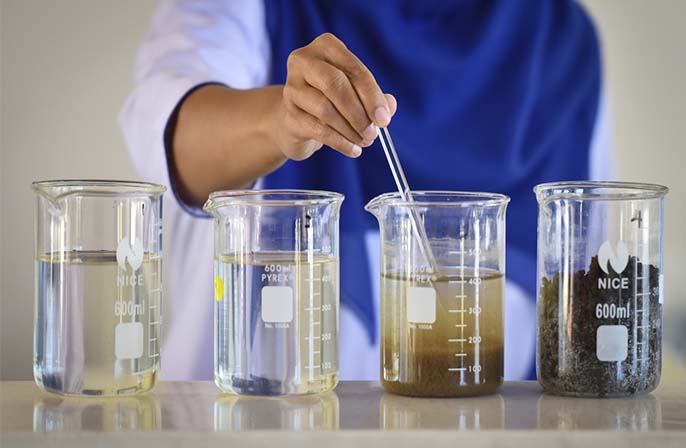New Trends in Industrial Wastewater Treatment: How to Replace Sodium Sulfide?
Modern Wastewater Treatment Technologies: Alternatives to Sodium Sulfide and Environmental Innovations

With the rise of environmental awareness and increased focus on worker safety, the industry is actively seeking more eco-friendly and efficient chemicals and technologies for wastewater treatment. Traditionally, sodium sulfide (Na₂S) has been widely used for removing heavy metal contaminants. However, its application may generate toxic hydrogen sulfide gas (H₂S) during the process, posing potential risks to both the environment and human health. As a result, the development of safer and more effective alternative agents and technologies has become a key direction in the advancement of the wastewater treatment field.
Applications and Limitations of Sodium Sulfide (Na₂S)
- Application Principle
- Sodium sulfide is primarily used to remove heavy metal ions (such as Ni²⁺, Pb²⁺, Cu²⁺) from industrial wastewater.
- The typical reaction is as follows:
M²⁺ + S²⁻ → MS↓
- Key Issues
- Hydrogen Sulfide Generation: Easily releases H₂S gas, which is foul-smelling and toxic.
- Operational Risks: Sodium sulfide is corrosive and may pose hazards to both equipment and personnel
- Environmental Pollution Risk: Residual sulfides may impact water quality and cause secondary pollution.
- Limited Treatment Efficiency: Less effective at treating chelated heavy metals, such as Cu-EDTA complexes.
Comparison of Heavy Metal Capturing Agents
| Type | Advantages | Disadvantages |
|---|---|---|
| Sodium Sulfide (Na₂S) | Low cost; capable of removing various metals | Produces hydrogen sulfide, which is harmful to humans; less effective on chelated metals |
| Dimethyldithiocarbamate | Strong heavy metal removal capability | May produce odor under low pH conditions |
| Polythiocarbonate (PTC) | Wide operating range; low toxicity | Longer reaction time |
| Trisodium Polythiocyanurate | Fast reaction speed | Higher cost; requires larger dosage |
Case Study: Application of Heavy Metal Scavenger in Desmear Wastewater Treatment
1. Background
A printed circuit board (PCB) manufacturing facility generates desmear wastewater from its electroplating and electroless plating processes. The main components of this wastewater include:
- Heavy metal ions (e.g., Cu²⁺, Ni²⁺)
- Chelating agents (e.g., EDTA, NTA)
- Acidic and alkaline waste solutions
- Residual organic additives
Due to the complex composition of this type of wastewater, traditional sodium sulfide treatment may be ineffective in removing chelated copper. Therefore, a highly efficient copper removal agent, KT-C88, was introduced to improve the treatment process.
2. Treatment Results
| Parameter | Before Treatment (ppm) | After Treatment (ppm) | Removal Efficiency |
|---|---|---|---|
| Cu | 267 | 1.5 | 99.4% |
Development Trends in Alternative Technologies
In recent years, many alternative technologies have been actively developed to enhance heavy metal removal efficiency and reduce environmental impact.
Key innovations include:
- Nanomaterial-Based Adsorption Technology
- Utilizes nanostructured materials such as nano iron oxides, carbon-based nanomaterials, or functionalized silica to enhance heavy metal adsorption.
- Offers high selectivity and is effective for removing trace concentrations of heavy metal ions.
- Bioadsorption Technology
- Employs microorganisms or biological materials (e.g., chitosan, algae) to capture heavy metals from wastewater.
- Renewable and eco-friendly, particularly suitable for low-concentration wastewater treatment.
- Electrochemical Precipitation Technology
- Uses electrode reactions to precipitate heavy metal ions onto the cathode surface, allowing for metal recovery and reuse.
- Effective in treating high-concentration and mixed-metal wastewater.
- Ion Exchange Resin Technology
- Applies selective ion exchange resins to capture heavy metals, enabling recycling and reuse of the treated water.
- Offers high efficiency and selectivity, but typically involves higher operational costs.
Conclusion and Future Outlook
Replacing sodium sulfide with heavy metal capturing agent can significantly improve wastewater treatment performance while reducing environmental and health risks. Looking ahead, as water treatment technologies continue to advance, the industry will move toward more eco-friendly and efficient solutions.
As environmental regulations become increasingly stringent and the demand for sustainable technologies in the industrial sector continues to grow, the future of wastewater treatment is expected to evolve in the following directions:
- Development of new eco-friendly capturing agent: Focus on non-toxic, highly selective agents for heavy metal removal.
- Smart monitoring and automated control: Leverage AI and IoT technologies to enhance treatment efficiency and system stability.
- Resource recovery and reuse: Embrace circular economy principles by recovering and reusing heavy metals to reduce waste and maximize value.
If you have any needs related to heavy metal wastewater treatment, please feel free to contact us. We are committed to providing the most suitable solutions to help you achieve your environmental and compliance goals!
CONTACT US
Kelly Chemical Corporation
Electronics
TEL:(02)2762-1985 ext 11200
Online Message
Leave your contact information,
and we will get in touch with you soon.
Email Consultation
After receiving your email,
we will process it as soon as possible.send Email